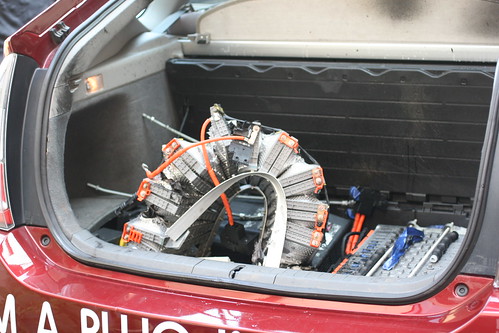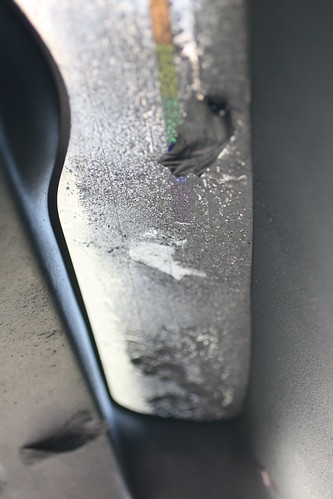It’s probably come to the attention of many readers at www.aminorjourney.com that things haven’t gone quite as well as they normally do.
I’ve got several articles planned, but in the past week I’ve been rather quiet. Aside from the fantastic Tesla launch party last week which I was privileged enough to take part in there’s been a few nasty things happening in my own family fleet.
On Thursday morning, at about 1am, one of the battery packs in my DIY converted PHEV Prius blew up.
I say ‘blew up’, but it was really rather more akin to popcorn. Except the sounds I was hearing were quite loud and quite dangerous. We’re still not entirely sure what’s happened, but it seems that at least two of the battery cells in one of the second-hand Prius battery packs I’d added to my stock Prius had shorted, causing the batteries to charge unequally.
 A PHEV pack should not look like this.
A PHEV pack should not look like this.
The three prius battery packs in my car were in parallel. As soon as one pack starts to short out cells the other cells in the pack start to become quite easily over-charged. As a consequence we think that the remaining cells went into a thermal runaway situation and, egged on by the hot weather that night the battery built up so much energy and pressure that it could only relase the energy in one way: A gaseous explosion.
The explosion wasn’t a combustive one – more a pressure oriented one. It did, however, leave the inside of Velma with a very heavy thick mist, made of the innards of a NiMH battery – chemicals which aren’t generally designed to be inhaled. Bits of batteries hung off the back window and the battery temperature reached well over 50 degrees Celsius.
In order to prevent the whole of my house going up in an explosive mess, I opened up the back of the car and desperately tried to cool the battery packs down and make the car safe. Unfortunately in the process I neglected to wear appropriate face mask protection… and then I ended up in hospital with respiratory problems.
Discharged from the emergency room a few hours later and without much in the way of sleep to go on I wasn’t in a fit state to blog about my experiences. I also didn’t want to publicly say too much until I knew more about what had caused the problem and what the insurance company had to say about the whole affair.
There wasn’t much nice left in Velma. The whole interior smells of hydrogen. Little pieces of Cobalt and Nickle lie in a fine dust on the seats and in the battery compartment. Thanks to the excellent photographic skills of John Honniball we have some photographs of just how bad things got.
 Bits of battery aren’t meant to be on the back window.
Bits of battery aren’t meant to be on the back window.
Luckily the insurance company (who knew about the modifications I’d made and had agreed to them) have been absolutely cool. The Insurance Adjustor came this morning and didn’t even want to look in the back. He has said that Velma will be classed as a Category B insurance write-off – in other words, she’ll not be allowed on the road again. It’s likely that she’ll be immediately crushed.
It’s a gutting experience.
I feel terrible about the whole thing, but it does look as if the problems were caused by a battery short. It doesn’t however excuse the care and attention that anyone wanting to do any type of EV conversion or PHEV work on their own. It’s not a Sunday walk in the park. Double, Triple and Quadruple check everything – and make sure that you have more safety features (both driving and charging) than you ever thought you’d need.
Again, I feel it’s important here to say that the method I used, which is based on the excellent work of the CalCars initiative and the wonderful open source project which has surrounded it, is not to blame here. Nor are those who seek to convert a Prius to a PHEV. Collectively, well over 1,000 cars prove that they’re safe and that they work. Velma’s explosion is not something you can blame these projects for. Nor can you blame the excellent work of Norm at HybridInterfaces. In hindsight perhaps there were things we could have done differently to try and help prevent such a nasty event – more charger monitoring, more cooling and more cell monitoring.
So, thank you Velma, for your fantastic fuel economy and very brief time with us. You have been an inspirational car and have taught me a lot about the importance of the PHEV in our future motoring landscape.
While I wait for the insurance pay-out, perhaps someone could suggest the next car. We’re leaning back towards owning another EV. Perhaps a bit larger than my first one….